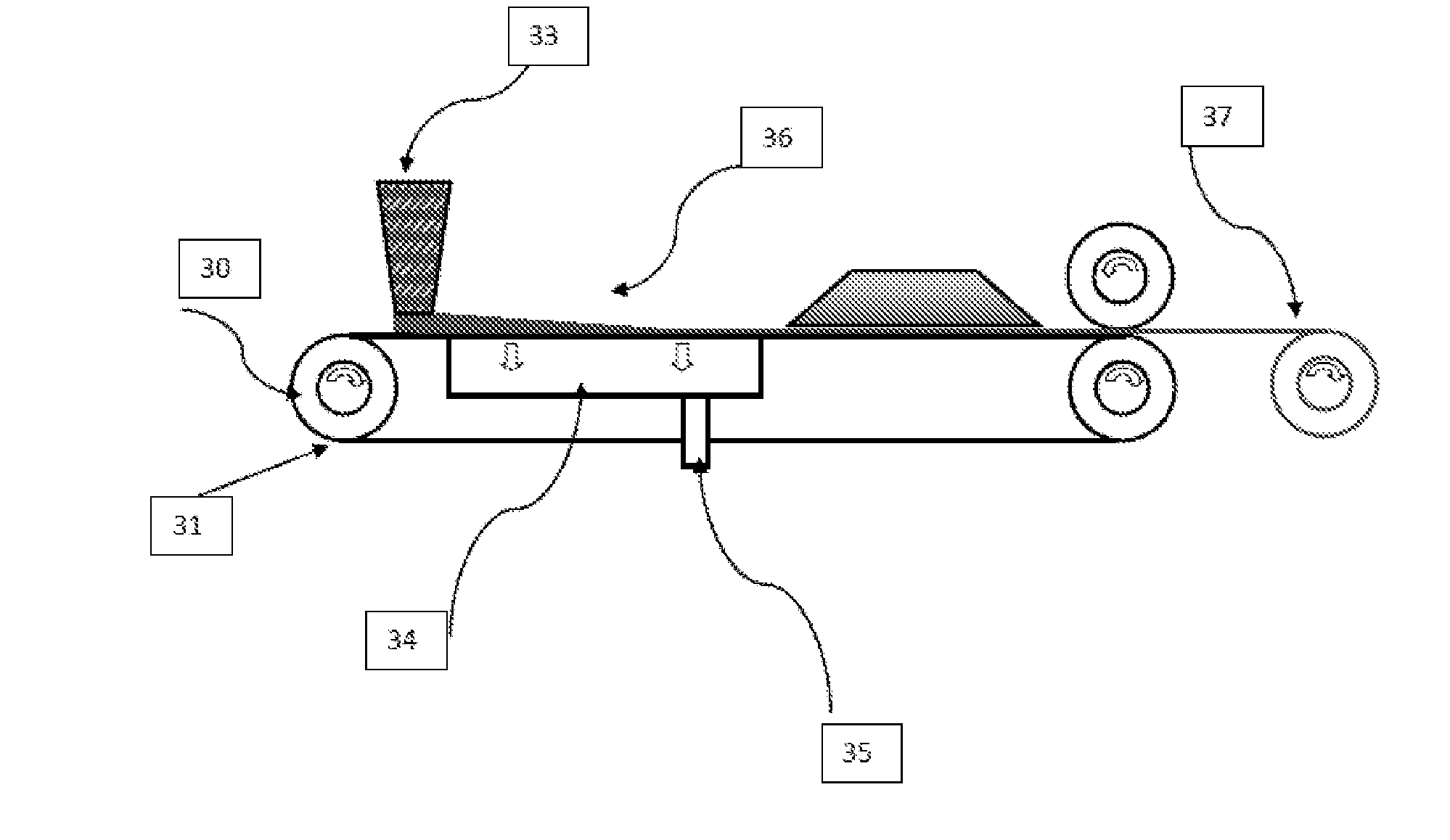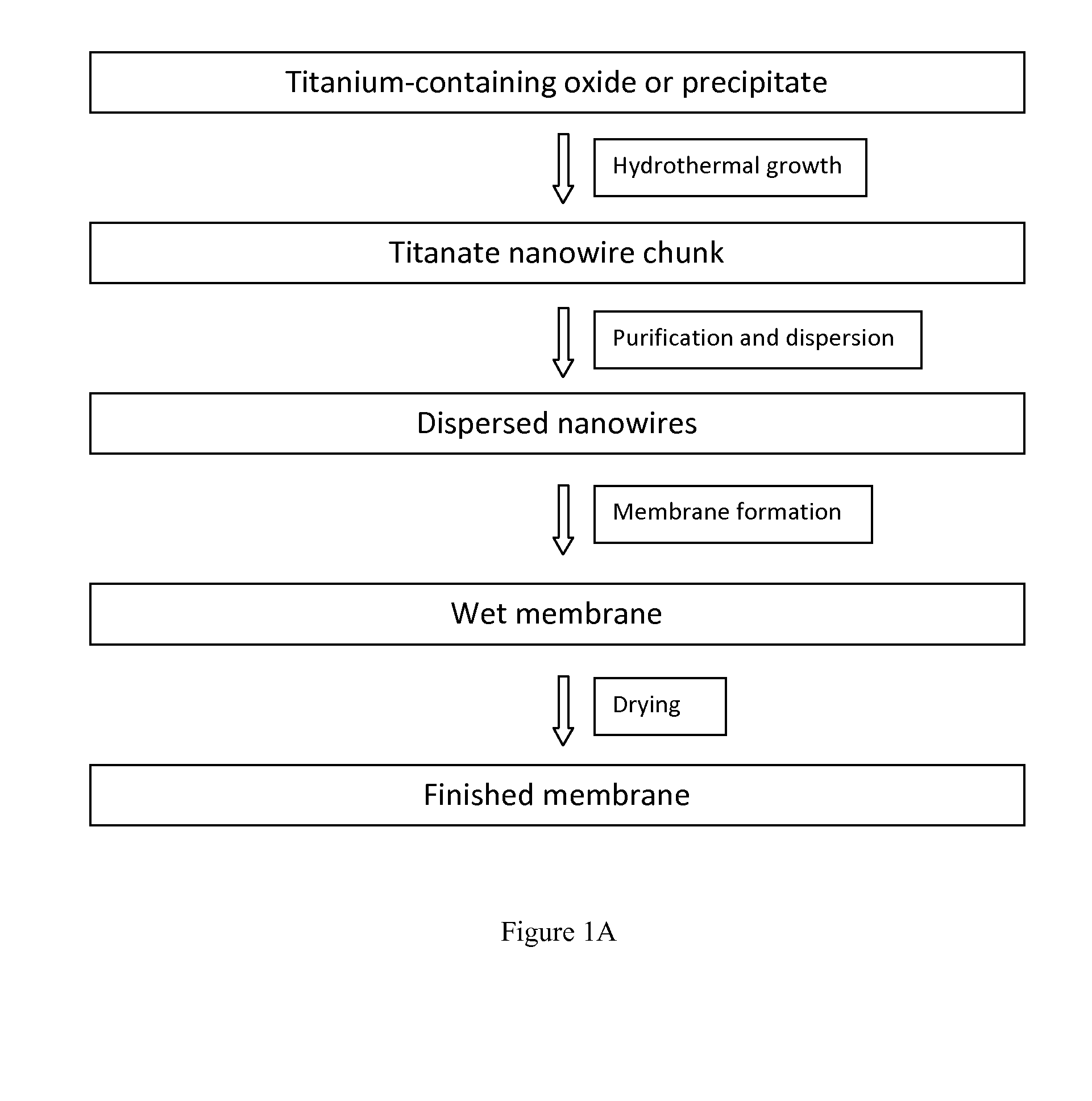Ceramic nanowire membranes and methods of making the same
a ceramic nanowire and nanowire technology, applied in the field of membranes, can solve the problems of limited operation temperature below 300° c, inability to use many organic solvents, high cost and tendency to brittleness, and achieve the effect of strong membranes
- Summary
- Abstract
- Description
- Claims
- Application Information
AI Technical Summary
Benefits of technology
Problems solved by technology
Method used
Image
Examples
experimental examples
[0126]1. Formation of Potassium Titanate Nanowires from Titania Nanopowder
[0127]To one liter of a 10M potassium hydroxide (KOH) solution in a two liter polytetrafloroethylene (PTFE) lined stainless steel pressure vessel was added 45 grams of titania nanopowder (Aeroxide® P25, Acros, Pittsburgh Pa.). The mixture was stirred and the resulting slurry was mixed thoroughly. The pressure vessel was sealed and out into a convective oven (MTI Corp. CA) at 230° C. for 24 hours. A whitish gelatinous bulb was formed. Transmission electron microscopy (TEM) showed nanowire structures with diameters of about 10 nm and an interlinked macrostructure with multiple nanowires connected to form clusters or agglomerates.
2. Preparation of Titanium-Containing Wet Precipitate
[0128]In a 1 L beaker 200 ml titanium isopropoxide (Alfa) was added dropwise to a solution of 400 ml ethanol (Alfa) and 40 ml DI water with vigorous stirring. After complete addition the slurry was stirred for another hour. The white s...
example 1
Preparing Bonded Ceramic Nanowire Membranes Using Base Precipitated Salts
[0142]It is possible to make bonded ceramic nanowire membranes using suitable salts precipitated by bases. Suitable salts include Titanium oxysulfate, Aluminum nitrate, aluminum sulfate, zirconium sulfate, zirconium oxynitrate, aluminum chloride, and zirconium oxychloride.
[0143]The procedure is illustrated by the following example.
[0144]Prepare a solution (w / w) of the salt in water. Adjust pH to less than 7 as needed to assure complete dissolution. Combine with ceramic nanowires to make up a membrane forming slurry checking to maintain an acidic condition. Add sufficient strong base solution with vigorous stirring to precipitate the salt. This will result in a slurry of nanowires, precipitated salt and nanowires with salt precipitated or coated onto nanowires. The membrane is formed in the usual manner by filtration and washed thoroughly with water. The wet membrane is dried by heat pressing or in any of the us...
example 2
Preparing Bonded Ceramic Nanowire Membranes Using Metal Esters
[0145]It is possible to make nanowire membranes using suitable metal esters. For example, Titanium(IV) methoxide, Titanium(IV) ethoxide, Titanium(IV) propoxide, Titanium (IV) isopropoxide, Titanium(IV) butoxide, Titanium(IV) tert-butoxide, Titanium diisopropoxide bis(acetylacetonate), Titanium(IV) 2-ethylhexyloxide, Titanium(IV) tetrachloride, silicon chloride Tetramethoxysilane, Tetraethyl orthosilicate (TEOS), Tetra-n-propoxysilane, Silicon tetrabutanoxide, Silicon tetraacetate, Aluminum trimethoxide, Aluminum ethoxide, Aluminum tributoxide, Aluminum-tri-sec-butoxide, aluminum acetylacetonate, Zirconium(IV) ethoxide, Zirconium(IV) isopropoxide, Zirconium(IV) propoxide, Zirconium(IV) butoxide, Zirconium(IV) tert-butoxide, Zirconium acetate, Zirconium acetylacetonate.
[0146]The procedure is illustrated by the following example.
[0147]To an alcohol / water slurry consisting of ceramic nanowires is added an alcohol solution of ...
PUM
| Property | Measurement | Unit |
|---|---|---|
| Diameter | aaaaa | aaaaa |
| Tensile strength | aaaaa | aaaaa |
| Tensile strength | aaaaa | aaaaa |
Abstract
Description
Claims
Application Information
 Login to View More
Login to View More - R&D
- Intellectual Property
- Life Sciences
- Materials
- Tech Scout
- Unparalleled Data Quality
- Higher Quality Content
- 60% Fewer Hallucinations
Browse by: Latest US Patents, China's latest patents, Technical Efficacy Thesaurus, Application Domain, Technology Topic, Popular Technical Reports.
© 2025 PatSnap. All rights reserved.Legal|Privacy policy|Modern Slavery Act Transparency Statement|Sitemap|About US| Contact US: help@patsnap.com



